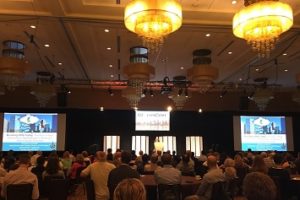In their keynote speeches during the Opening General Session of this year’s StormCon conference in Bellevue, Washington, Dominique Lueckenhoff, the Acting Director of EPA Region 3’s Water Protection Division, and Mami Hara, the General Manager and CEO of Seattle Public Utilities, underscored the need for innovative community- and industry-driven approaches to the problems presented by the nation’s aging stormwater infrastructure.

In light of changing weather patterns, the associated increase in the frequency of super storms, and the deterioration of the majority of the U.S.’s water infrastructure that was installed in the early to mid-20th century, Lueckenhoff asserted that stormwater is the fastest growing water quality problem in many parts of the country, and that $271 billion will be needed to overhaul the infrastructure over the next 25 years. Consequently, regulatory agencies, the stormwater industry, and regulated communities will have to embrace innovative technologies and collaborative partnerships in order to maximize the efficiency of current systems in the short-term and retrofit aging infrastructure when needed.
Innovative Technology
In terms of technology, both speakers championed industry-led use and development of green infrastructure and integration of wastewater and drainage systems. Additionally, advances in “next gen” technology, such as real time controls for best management practices (BMPs) like flow and water depth sensors, green roofs, and high flow media systems, will optimize existing infrastructure by increasing efficiency. The data gleaned from many of these new technologies will also help drive stormwater policy and control decision making in the years to come.
Collaborative Partnerships
Perhaps more important than technological advancements, however, is the new focus on collaborative partnerships between the public and private sectors. One such type of partnership, called a Community- Based Public-Private Partnership (CBP3), is a “game changer” according to Lueckenhoff. CBP3s are performance-based, economic development partnerships between local governments and private entities that assist communities with financing and implementing large-scale green stormwater infrastructure and integrated development projects. As agencies and communities are being asked to “do more with less,” they are turning to the CBP3 as a new tool for responding to the growing stormwater problem.
Customizable for a community’s financing and infrastructure goals, the CBP3 approach has already proven successful in Prince George’s County, Maryland, and is currently being used in Chester, Pennsylvania. By leveraging the private sector’s financial resources for investment into infrastructure improvements, the CBP3 is a market-based approach that will help address the growing demands on municipalities’ stormwater management programs.
For more information on CBP3s, go here.
Additionally, Hara discussed peer networks of city utilities that are forming to exchange ideas and continue to advance the development of green infrastructure across regions.
The Takeaways
Both Lueckenhoff and Mara stressed that green stormwater and integrated water infrastructure are emerging markets that will help solve the growing stormwater management crisis, and that industry and communities are being presented with exciting opportunities for involvement and innovation in arriving at effective solutions. As regulatory and industry strategies begin to evolve in the face of weather and budgetary changes, the next few years are sure to see new technologies and approaches continue to develop.
